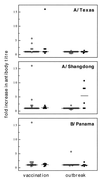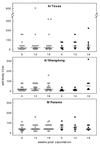Assessment of markers of the cell-mediated immune response after influenza virus infection in frail older adults
- PMID: 9801346
- PMCID: PMC96213
- DOI: 10.1128/CDLI.5.6.840-844.1998
Assessment of markers of the cell-mediated immune response after influenza virus infection in frail older adults
Abstract
The purpose of this study was to determine whether measures of the cell-mediated immune response to influenza virus could be used as markers of influenza virus infection. We studied 23 subjects who developed upper respiratory, lower respiratory, or systemic symptoms during a small outbreak of influenza in a nursing home population. Influenza virus culture from nasopharyngeal swabs yielded influenza virus isolates from 7 of the 23 subjects. Only three of the subjects had a fourfold rise in antibody titer to the influenza virus antigen positivity after the infection. Granzyme B and cytokine levels were measured in peripheral blood mononuclear cells (PBMC) obtained from all subjects and stimulated with live influenza virus. Elevated granzyme B levels in virus-stimulated PBMC in combination with lower respiratory tract or systemic symptoms in study subjects was a significant predictor of culture-confirmed influenza virus infection compared to those from whom influenza virus could not be identified. Cytokine levels did not distinguish between the two groups in a similar type of analysis. Granzyme B in combination with the clinical profile of symptoms may be a useful retrospective marker for influenza virus infection.
Figures






Similar articles
-
T cell responses are better correlates of vaccine protection in the elderly.J Immunol. 2006 May 15;176(10):6333-9. doi: 10.4049/jimmunol.176.10.6333. J Immunol. 2006. PMID: 16670345
-
Influenza Vaccine-Induced Antibody Responses Are Not Impaired by Frailty in the Community-Dwelling Elderly With Natural Influenza Exposure.Front Immunol. 2018 Oct 24;9:2465. doi: 10.3389/fimmu.2018.02465. eCollection 2018. Front Immunol. 2018. PMID: 30405641 Free PMC article. Clinical Trial.
-
Upper respiratory tract infection and serum antibody responses in nursing home patients.Am J Infect Control. 1988 Aug;16(4):152-8. doi: 10.1016/0196-6553(88)90026-0. Am J Infect Control. 1988. PMID: 2847597 Free PMC article.
-
Granzyme B: a marker of risk for influenza in institutionalized older adults.Vaccine. 2001 Jun 14;19(27):3744-51. doi: 10.1016/s0264-410x(01)00087-1. Vaccine. 2001. PMID: 11395209 Clinical Trial.
-
Prospects for broadly protective influenza vaccines.Vaccine. 2015 Nov 27;33 Suppl 4:D39-45. doi: 10.1016/j.vaccine.2015.08.053. Epub 2015 Sep 1. Vaccine. 2015. PMID: 26338145 Review.
Cited by
-
Clinical and immunologic predictors of influenza illness among vaccinated older adults.Vaccine. 2010 Aug 31;28(38):6145-51. doi: 10.1016/j.vaccine.2010.07.036. Epub 2010 Jul 31. Vaccine. 2010. PMID: 20646987 Free PMC article.
-
Vaccinomics and a new paradigm for the development of preventive vaccines against viral infections.OMICS. 2011 Sep;15(9):625-36. doi: 10.1089/omi.2011.0032. Epub 2011 Jul 6. OMICS. 2011. PMID: 21732819 Free PMC article. Review.
-
Correlation of cellular immune responses with protection against culture-confirmed influenza virus in young children.Clin Vaccine Immunol. 2008 Jul;15(7):1042-53. doi: 10.1128/CVI.00397-07. Epub 2008 Apr 30. Clin Vaccine Immunol. 2008. PMID: 18448618 Free PMC article. Clinical Trial.
References
-
- Barker W, Mullooly J. Impact of epidemic type A influenza in a defined adult population. Am J Epidemiol. 1980;112:798–811. - PubMed
-
- Barker W, Mullooly P. Pneumonia and influenza deaths during epidemics: implications for prevention. Arch Intern Med. 1982;142:85–89. - PubMed
-
- Drinka P J, Krause P, Schilling M, Miller B A, Shult P, Gravenstein S. Report of an outbreak: nursing home architecture and influenza-A attack rates. J Am Geriatr Soc. 1996;44:910–913. - PubMed
-
- Ennis F A, Rook A H, Qi Y L, et al. HLA-restricted virus-specific cytotoxic T lymphocyte responses to live and inactivated influenza viruses. Lancet. 1981;ii:887–891. - PubMed
Publication types
MeSH terms
Substances
Grants and funding
LinkOut - more resources
Full Text Sources
Medical

